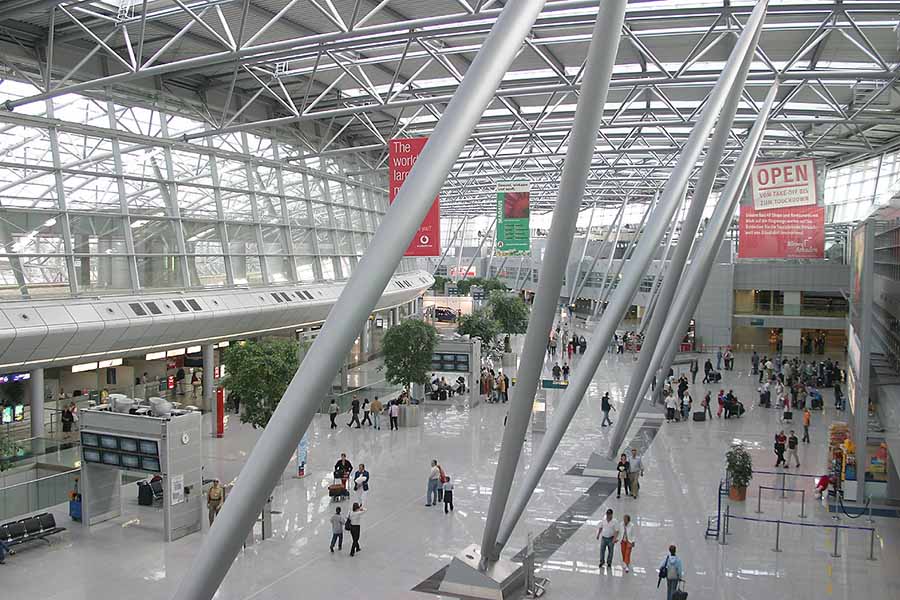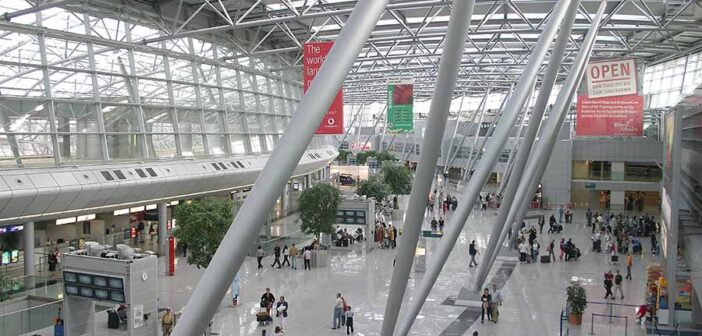
Düsseldorf International Airport, or DUS, offers a modern and efficient experience for travellers exploring Germany’s Rhine-Ruhr region, handling over 20 million passengers annually across 179 destinations.
The passenger experience is shaped by its single-terminal design with three concourses—A, B, and C—connected by a central spine. Serving as a hub for Eurowings and a focus city for Lufthansa, Condor, and SunExpress, the airport features clear signage and a bright, airy layout with local touches like an observation deck in Terminal B offering views of aircraft operations. The terminal’s modern architecture, with ongoing upgrades like expanded parking, ensures a welcoming atmosphere, though summer peaks can make it feel busy.
Accessing the airport from Düsseldorf’s city centre, 7 kilometres away, is quick and convenient. The S-Bahn S11 train connects the airport’s terminal station to Düsseldorf Central Station in 12 minutes for £2.50, running every 20 minutes. The SkyTrain monorail links the terminal to the long-distance Düsseldorf Flughafen station, 5 minutes away, serving ICE and regional trains. Bus line 721 reaches the city in 20 minutes for £2, while taxis and rideshares like Uber, available outside arrivals, cost £15-£20 for a 10-minute ride. Car rental agencies like Sixt and Hertz are in the arrivals hall, and parking options include on-site garages at £4 per hour and long-term lots at £20 per week, bookable online via Parkwell.com.
The airport’s layout features a single terminal with Concourse A (16 gates for Lufthansa and Star Alliance), Concourse B (11 gates for domestic and Schengen flights), and Concourse C (8 gates for non-Schengen flights). The SkyTrain and walkways connect all areas, with security on Level E2 and baggage claim on Level E0. Long walking distances to Concourse C and bus transfers to remote stands can add time, and ongoing construction for runway extensions may cause minor disruptions. Schengen-to-Schengen transfers avoid passport control, while non-Schengen connections require it, impacting transfer times.
Delays can occur during peak summer months or due to winter fog, with security queues in Concourse A and immigration in Concourse C slowing progress during busy periods. Baggage claim for international flights may take 30-45 minutes, so arriving two hours early for domestic flights and three for international is advised. Checking flight status via in-airport displays or apps like Flightradar24 helps manage gate changes.
Dining options include local specialities at Früh am Dom in Concourse A, serving Altbier and German dishes, alongside international chains like McDonald’s and Starbucks in the central spine. Most eateries close by 10 pm.
, but 24-hour vending machines and a supermarket in the main terminal offer snacks. Retail features duty-free shops by Heinemann in Concourse C, selling perfumes and alcohol, plus luxury brands like Hugo Boss and WHSmith for souvenirs and essentials. The observation deck adds a unique plane-spotting experience.
Facilities cater to diverse needs, with free Wi-Fi via “DUS Airport Free WiFi” (premium options available), charging stations, and a 24-hour meditation room on Level 3. Accessibility services include ramps, lifts, and wheelchair assistance, bookable 48 hours in advance. Seven lounges, like the Lufthansa Business Lounge and Hugo Junkers Lounge, offer snacks, Wi-Fi, and showers for a fee. Prayer rooms in Concourse C, a pharmacy, and ATMs enhance convenience, though no dedicated nursing rooms are available. Nearby hotels like the Maritim, 500 metres away, serve layovers.
On-time performance is generally reliable, supported by two runways handling 750 daily movements, though weather and peak-hour congestion can cause delays. Connections are efficient, with a minimum transfer time of 35 minutes, though Schengen-to-non-Schengen transfers require 45-60 minutes due to passport control. Self-transfers need at least an hour to ensure gate access.
Aer Lingus
Aer Lingus check-in is in Terminal 1, Check-in Counter Area C (dynamic desks in C zone; self-service kiosks available). Departures are most commonly from Pier C (non-Schengen; gates C20-C61); dynamic, announced ~40 minutes before departure.




